산업기술








창고 레이아웃을 설계하는 것은 간단한 작업처럼 보이지만 실제로는 상당히 복잡합니다. 실제로 창고의 설계와 레이아웃은 작업 생산성을 좌우할 수 있으며 피킹 시간, 노동 시간에 영향을 미치며 교통 흐름이 좋지 않아 안전 위험이 증가할 수도 있습니다.
50명의 전문 창고 설계 및 레이아웃을 모았습니다. 창고 생산성을 최적화하고 안전을 강화하기 위해 시설에 이상적인 레이아웃을 설계하는 데 도움이 되는 아이디어, 팁 및 전략. 특정 섹션의 도움말로 이동하려면 아래 링크를 클릭하십시오.
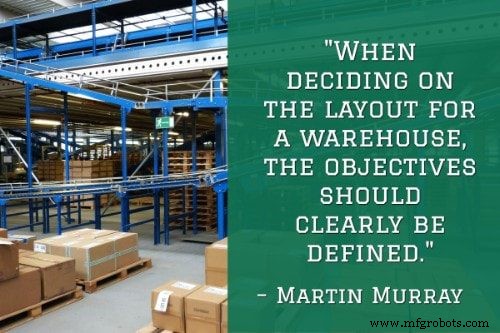
1. 계획 프로세스를 시작하기 전에 목표를 정의하세요. “창고의 레이아웃을 결정할 때 목표를 명확하게 정의해야 합니다. 목표는 회사의 전반적인 창고 전략과 일치해야 합니다. 목표는 창고 비용을 절감하거나 최대의 고객 서비스를 제공하는 것과 같이 높은 수준에서 정의될 수 있습니다.
“마찬가지로 목표는 창고 공간 최대화, 창고의 최대 유연성 제공 또는 자원을 늘리지 않고도 창고 효율성을 높일 수 있습니다." – Martin Murray, 창고 레이아웃 계획 및 최적화 – 공급망 영향 , 균형 소기업; 트위터:@thebalance
2. 지역 건축 법규를 알아두세요. “창고 제품 보관에 관한 지역 건축 법규를 숙지하십시오. 예를 들어 팔레트 적재물의 상단에서 스프링클러 헤드까지 필요한 최소 간극은 얼마입니까? 귀하의 창고가 특별한 설계 고려 사항이 필요한 지진 지역에 있습니까? 출구 경로, 지게차 통로 대 보행자 통행량 등과 같은 모든 안전 고려 사항을 알고 있어야 합니다.” – Kim Stebbins, 창고 레이아웃 및 디자인:팔레트 랙을 주문하기 전에 알아야 할 사항 , 차세대 스토리지 솔루션; 트위터:@NextLevelMHE
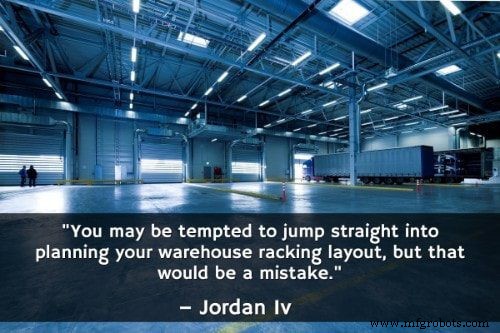
3. 관리자와 계약업체의 의견을 구하세요. “창고 랙 레이아웃을 계획하기 위해 곧바로 뛰어들고 싶지만 그것은 실수입니다. 시작하기 전에 지식이 풍부한 계약자(예:자재 취급 회사), 창고 관리자 및 운전기사와 상의하십시오. 그들은 특정 창고에서의 경험은 말할 것도 없고 창고 시설 운영 및 계획에 대한 수년간의 경험이 있습니다. 목표와 요구 사항을 설명하고 그들의 제안에 귀를 기울이십시오.” – Jordan Iv, 창고 랙 레이아웃을 설계하는 방법:효율적인 계획을 위한 10단계 , 링크드인
4. 창고 관리 시스템(WMS)의 과거 데이터를 활용하십시오. WMS가 없다면 지금이 투자하기에 좋은 시기입니다. “오늘날과 같이 경쟁이 치열한 비즈니스 환경에서 데이터 수집은 필수적입니다. 오늘날의 창고 관리 시스템(WMS)은 재고를 추적할 뿐만 아니라 중요한 운영 데이터를 수집합니다. 종종 WMS는 기존의 제품 가치 기반 ABC 분류에서 유동 재고 창고 레이아웃과 같은 반직관적이지만 매우 효율적인 접근 방식으로 제품 슬롯 철학을 변경하는 것과 같은 급진적인 권장 사항을 제시할 수 있습니다.
“구현하는 것이 좋습니다. 다운스트림 오류를 방지하기 위한 자동화된 자산 추적 데이터 수집 방법 — 수동 입력은 아니오입니다. 한 단계 더 나아가 자산에 고유한 추적 번호를 할당하고 일련 번호(고유하지 않은 경우가 많음)에 의존하지 마십시오. 그리고 이동 자산뿐만 아니라 고정 자산도 추적하십시오.” – Cody Adams, 궁극적인 창고 디자인 및 레이아웃을 위한 13가지 팁 , 포르마스페이스; 트위터:@RealFormaspace
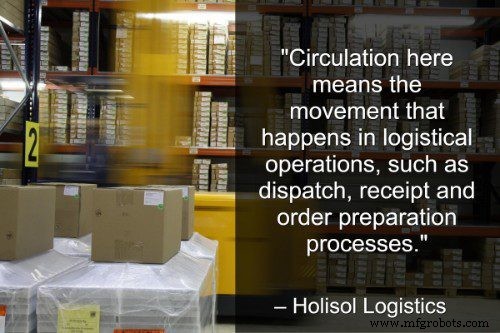
5. 시설을 통해 상품이 순환하는 방식을 이해합니다. “여기서 순환이란 발송, 입고, 주문 준비 과정과 같은 물류 작업에서 일어나는 이동을 의미합니다. 제품 순환은 상품이 얼마나 자주 갱신되는지입니다. 즉, 순환이 많은 제품은 투입 및 산출 비율이 높은 제품입니다. 짐을 옮기는 데는 비용이 수반되므로 회사 운영 절차에서 허용하는 한 이동을 최소화하는 것이 좋습니다. 이러한 흐름을 감지하는 것은 효과적인 창고 설계에 필요한 것을 정의하는 데 기여하므로 매우 중요합니다.” – 완벽한 창고 디자인을 위한 5가지 요소 , 홀리솔 물류; 트위터:@HolisolLogistic
6. 창고의 다양한 영역 간의 공간 관계를 결정합니다. “프로젝트가 명확하게 정의되면 프로세스의 2단계는 창고 영역을 배치하기 위한 전체 계획을 개발하는 것을 목표로 합니다. 이 단계에서 레이아웃의 매우 구체적인 세부 사항은 의도적으로 무시됩니다. 그러나 레이아웃의 다른 측면은 면밀히 평가됩니다.
“이 단계를 시작하는 가장 논리적인 방법은 창고 영역 간의 공간적 관계를 결정하는 것입니다. 영역 간의 관계를 그릴 때 고려해야 할 많은 측면이 있습니다. 한 요인의 중요성과 영향을 과대평가하거나 과소평가하면 창고의 흐름에 해로울 수 있습니다. 우리 컨설팅 팀은 이 문제를 해결하기 위해 논리적인 평가 시스템을 사용합니다.
“이 단계의 다음 단계는 각 영역에 필요한 공간의 양을 결정하는 것입니다. 이 작업을 수행하는 방법에는 여러 가지가 있습니다. 특정 방법은 주어진 상황에서 다른 방법보다 더 잘 작동할 수 있습니다. 예를 들어, 어떤 경우에는 시설에 배치할 영역에 대한 과거 정보가 없을 수 있지만 다른 시설은 공간 표준을 설정했을 수 있습니다.
“공간 요구 사항이 설정된 후 제한 사항을 설명하기 위해 조정할 수 있습니다. 각 지역의 특정 요구. 예를 들어, 일부 지역에는 출구 문이 필요할 수 있으며 다른 지역에 더 많은 통로 공간을 제공하는 것이 합리적일 수 있습니다.” – Marvin Logan, 더 나은 창고 레이아웃을 만드는 방법 , 바스티안 솔루션; 트위터:@BastianSolution
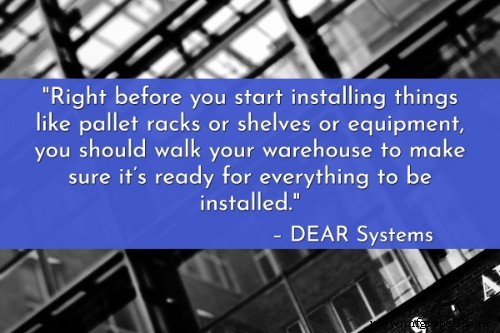
7. 새 선반과 랙 설치를 시작하기 전에 레이아웃 디자인을 테스트하세요. “팔레트 랙이나 선반 또는 장비와 같은 것을 설치하기 직전에 창고를 걸어다니며 모든 것이 설치될 준비가 되었는지 확인해야 합니다.
“마스킹 테이프를 사용하여 주요 작업 영역을 설명하고 물건을 운반하세요. 팔레트 잭을 돌리고 다른 직원들이 동시에 작업을 시뮬레이션하도록 합니다.
“이를 통해 공간이 최적화되었는지 여부를 시각적으로 이해할 수 있습니다. 여기에 오류가 있으면 나중에 더 큰 오류가 발생합니다.” – 창고 레이아웃 디자인을 효과적으로 계획하는 방법에 대한 4가지 팁 , 디어 시스템즈; 트위터:@DearInventory
8. 도식으로 시작하세요. “좋은 창고 레이아웃은 공간의 크기에 관계없이 항상 먼저 종이에 모든 것을 적는 것에서 시작됩니다. 이를 수행하는 가장 쉬운 방법은 특히 공간이 크거나 표준 직사각형 모양이 아닌 경우 창고 청사진 사본을 사용하는 것입니다. 임대하는 경우 집주인이 제공할 수 있습니다.
“청사진을 손에 넣을 수 없다면 그리드 종이에 자신만의 창고 도면을 그리기 쉽습니다. 나는 일반적으로 회로도에서 1제곱 =1제곱피트를 사용합니다.
“축척에 맞게 그려진 측정이 포함된 인쇄 또는 온라인 회로도가 있으면 기둥이나 지지대, 사무실 공간 구축, 설치된 장비와 같은 고정 기능을 기록해 두십시오. , 머리 위 문 등을 해결해야 합니다.
“내 창고에서 사무실 건물은 내가 계획해야 하는 중간 부분을 차지합니다. 나는 사무실 문이 창고로 열리므로 실수로 막지 않도록 주의합니다. 또한 배송 작업에서 오버헤드 도어 위치는 배송 및 수령 워크플로의 핵심이므로 이러한 용도를 위해 메모해 두었습니다.
“설계도가 준비되고 주요 기능이 기록되면 이제 시작할 때입니다. 당신의 공간을 계획하세요.” – Krista Fabregas, 창고 레이아웃 계획 – 효율적인 보관, 포장 및 배송 지역을 설정하는 방법 , FitSmallBusiness.com; 트위터:@FitSmallBiz
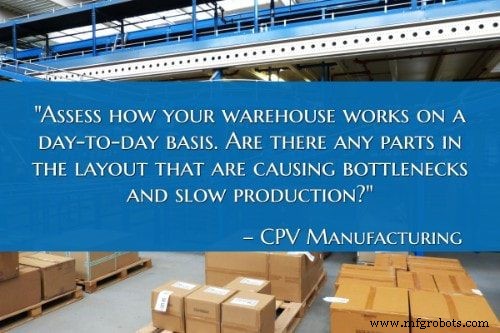
9. 프로세스 맵을 만듭니다. “창고가 매일 어떻게 작동하는지 평가하십시오. 레이아웃에 병목 현상과 느린 생산을 일으키는 부분이 있습니까? 그렇다면 원활하고 효율적인 워크플로우를 보장하기 위해 창고 레이아웃을 최적화해야 합니다.
“현재 시설이 어떻게 운영되고 있고 각 구역이 어디에 위치해 있는지 자세히 설명하는 프로세스 맵을 만드십시오. 그런 다음 변경해야 하는 영역을 선택합니다.
“다음으로 레이아웃 변경이 적용된 새 프로세스 맵을 만듭니다. 예를 들어, 생산 및 포장에서 병목 현상을 발견한 경우 새로운 프로세스 맵에서 생산 요구 사항을 쉽게 충족할 수 있도록 포장 영역을 이동할 수 있습니다.” – 비용 효율적인 창고 설계 방법:창고 레이아웃 설계 최적화 , CPV 제조; 트위터:@cpvmfg
10. 프로세스 외에도 인벤토리에 대한 심층적인 이해가 필요합니다. “작업 프로세스를 이해하는 것과 함께 그곳에 보관될 재고에 대한 이해가 필요합니다. 이를 위해서는 이러한 품목의 크기와 모양, 이러한 품목을 운송하는 데 필요한 자재 취급 장비 및 보관할 각 품목의 총량을 알아야 합니다. 이것은 여러 가지 이유로 중요할 것입니다.
“첫째, 항목의 크기가 중요합니다. 왜냐하면 이러한 항목이 차지하는 공간이 많을수록 동일한 항목이든 같은 항목이든 다른 인벤토리를 위한 공간이 줄어들기 때문입니다. 그렇지 않으면. 이것은 창고를 운영할 때 1제곱피트당 비용이 들기 때문에 중요합니다. 또한 각각을 이동하는 데 필요한 자재 취급 장비를 조사하는 것은 재고 보관 사이에 필요한 교통 차선의 너비에 영향을 미칩니다. 분명히 지게차나 기타 중장비가 필요한 품목은 더 넓은 차선이 필요합니다. 그러나 시설 직원의 전반적인 안전을 보장하기 위해 해당 지역의 전반적인 유동인구도 고려해야 합니다.” – 창고 계획 가이드:공간 활용 , 패널 내장, 통합; 트위터:@PanelBuilt
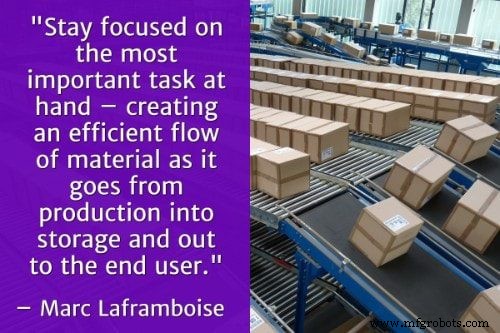
11. 지금은 창고 레이아웃만 디자인하지 마십시오. 또한 미래의 예상 성장을 수용할 수 있는 추가 디자인을 만들어야 합니다. “창고 레이아웃 디자인을 만들 때의 경험은 과밀한 기존 공간에서 방향을 찾기 위해 완전히 비어 있는 건물에 이르기까지 다양합니다. 두 가지 모두에 대한 나의 초기 권장 사항은 아이디어와 개념을 종이에 기록하는 것입니다.
“물론, 창고 레이아웃에 대한 AutoCAD 3D Design이 선명하게 보이는 것도 좋지만 기본부터 시작하여 종이에 연필. 당면한 가장 중요한 작업에 집중하십시오. 즉, 생산에서 저장으로, 최종 사용자에게 전달되는 자재의 효율적인 흐름을 만드는 것입니다.
“적절한 장비, 저장 매체 및 충분한 공간 – 그러나 모든 것이 귀하의 급속한 성장을 견딜 수 있도록 얼마나 잘 설계되었는지에 달려 있습니다. 미래의 성장을 예측하고 현재를 위한 디자인과 향후 몇 가지 다른 디자인을 만들어 보세요.” – Marc Laframboise, 창고 레이아웃 디자인 , 머티리얼 핸들러; 트위터:@MaterialH4ndler
12. 적절한 조명을 소홀히 하지 마세요. “창고의 조명이 약하면 작업자가 적절한 조명 계획이 있으면 쉽게 볼 수 있는 항목을 검색하는 데 불필요한 시간을 소비하게 됩니다. 열악한 작업자 생산성 외에도 열악한 조명은 교차 통로 교통 및 여행 위험을 포함하여 잠재적인 위험에 대한 낮은 가시성으로 인해 안전 문제를 일으킬 수 있습니다. 작은 라벨이 있는 품목을 보관하는 위치는 큰 라벨이 있는 항목을 보관하는 지역보다 더 많은 조명이 필요합니다.” – Justin Johnson, 제조 창고 레이아웃 모범 사례 , 크론; 트위터:@HoustonChron
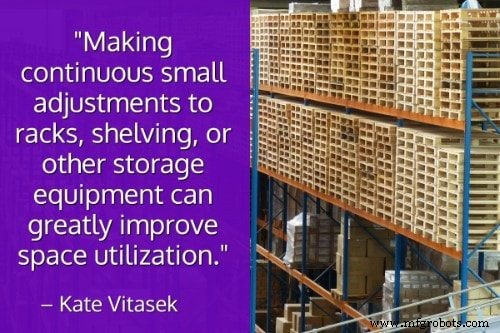
13. 창고 레이아웃과 프로세스를 정기적으로 검토하여 비효율성을 식별합니다. “대부분의 회사는 창고의 초기 레이아웃에 많은 노력을 기울입니다. 그러나 업계 설문조사에 따르면 절반 정도의 회사가 레이아웃을 검토하기 위한 지속적인 프로세스가 없습니다. 저장 영역이 어떻게 구성되어 있는지 검토하고 제품 혼합 변경에 따라 저장 영역을 재구성하는 프로세스를 갖추는 것은 모범 사례로 간주되며 높은 수준의 공간 활용도와 효율성을 유지하는 데 중요합니다. 랙, 선반 또는 기타 보관 장비를 지속적으로 조금씩 조정하면 공간 활용도를 크게 높일 수 있습니다.
“모든 창고 소프트웨어는 데이터에서 실행되므로 제품 및 보관 위치 데이터는 최신 상태로 정확하게 유지되어야 합니다. 모범 사례 회사는 단일 기록 시스템에서 모든 정보를 유지하고 정확한 최신 정보를 유지합니다. 제품 데이터에는 큐브 데이터, 로트/일련 번호 정보, 특별 요구 사항을 포함한 모든 제품 특성이 포함되어야 제품이 특수 보관 영역으로 이동할 수 있습니다. 냄새가 나거나 화재 위험이 있거나 온도 조절이 필요한 품목을 분리하기 위해 특수 보관 구역을 사용할 수 있습니다. 고부가가치 제품에는 케이지 또는 액세스 제어 스토리지가 필요할 수 있습니다.” – Kate Vitasek, 보관 및 재고 관리 모범 사례 , 다중 채널 판매자; 트위터:@mcmmerchant
14. 기존 창고 레이아웃을 재설계하는 경우 즉시 변경해야 할 사항과 구현하는 데 더 많은 시간이 필요한 변경 사항을 결정합니다. “변경을 시작하기로 결정했다면 즉시 시작하고 3~6개월 이내에 완료해야 하는 변경 사항과 구현하고 완료하는 데 더 오랜 시간이 필요한 변경 사항을 식별하십시오. 자본 집약적인 작업 항목을 결정하는 것도 마찬가지로 중요합니다. 이것들은 필요하거나 부차적일 수 있지만 장기적으로 필요할 것입니다.” – 시설 용량을 늘리는 방법을 식별하기 위한 창고 평가 , F. Curtis Barry &Company; 트위터:@FCurtisBarryCo
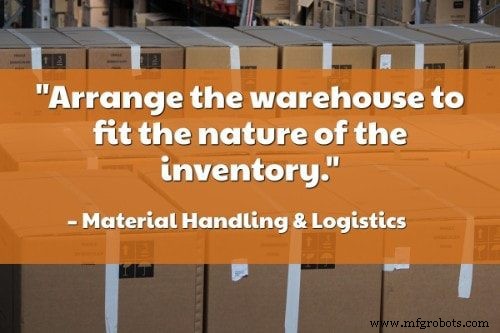
15. 간단한 스프레드시트 분석을 통해 다양한 깊이의 행 수와 필요한 랙 수에 대한 통찰력을 얻을 수 있습니다. “재고의 특성에 맞게 창고를 배치하십시오. 적은 수의 SKU를 대량으로 저장할 경우 깊은 행이 많이 필요합니다. 재고가 많은 SKU 중 소량일 경우 대부분의 면이 얕은 행이 더 실용적입니다.
“간단한 스프레드시트 분석은 다양한 깊이의 행 수와 필요한 랙 수를 계산합니다. 이를 통해 보관 및 통로에 필요한 면적을 계산합니다. 부두, 사무실 및 향후 확장을 위한 공간은 포함되지 않습니다.
“분석은 현재 재고의 '스냅샷'을 기반으로 하며 향후 변경 사항을 포함하도록 수정되었습니다. 개별 SKU는 주마다 다를 수 있지만 깊은 행과 얕은 행의 혼합은 놀라울 정도로 안정적이며 한 기간이 매우 대표적일 수 있습니다. 팔레트를 쌓을 수 있는 높이는 제품의 무게, 포장의 강도, 건물 높이 등에 따라 달라집니다.” – 창고 계획 , 자재 취급 및 물류
16. 시설에서 처리하는 SKU(및 제품 유형)의 수에 따라 적절한 도크 및 수용 공간을 계획합니다. “적절한 위치를 찾은 후 또는 기존 시설을 개조하는 경우에는 설계 단계로 바로 이동하고 운영 데이터를 평가하여 시설의 목표에 대한 통찰력을 얻습니다. 이 데이터를 사용하여 일일 생산 및 입고 주기를 분석합니다. 또한 하루 종일 변동하는 재고 수준을 설명하기 위해 데이터를 사용합니다. 이 정보는 프로세스 속도를 높이고 작업 공간을 통해 흐름을 만드는 레이아웃을 만드는 데 도움이 됩니다. 제품의 출처, 보관 위치, 시설 내 이동 빈도를 알면 공간을 현명하게 사용하는 디자인을 만들 수 있습니다.
“레이아웃 디자인의 주요 구성 요소 중 하나는 다양한 유형의 팔레트 하중을 수용할 수 있는 능력을 최적화합니다. 일부 창고는 받기 쉽고 보관하기 쉬운 하나의 SKU로 단일 팔레트를 처리합니다. 그러나 다른 창고에서는 저장하기 전에 검역 및 테스트가 필요한 많은 양의 화학 물질 및 기타 물질을 처리합니다. 하나의 SKU로 팔레트 적재를 처리하든 1000개로 처리하든 당사는 작업을 지원할 수 있는 입고 영역을 설계합니다. 충분한 도크와 수용 공간이 있는지 확인합니다.” – 레이아웃 디자인 , 창고1; 트위터:@warehouse1
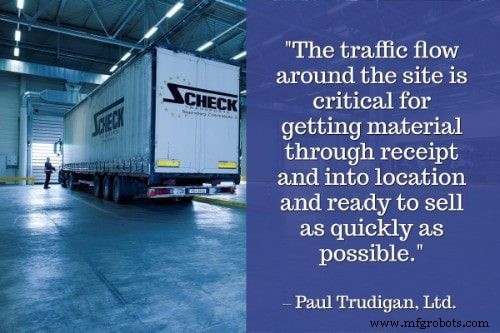
17. 슬롯 분석을 수행합니다. “이제 제품 범주, 속도 및 측정 단위별로 재고를 분리했으므로 다음 단계는 재고 균형을 맞추기 위해 슬롯 분석을 수행하는 것입니다. 슬롯 지정은 모든 전방 선택 및 예약 위치의 수량과 크기를 정의하는 프로세스입니다. 이는 전방 선택 위치에 배치할 제품 범주, 속도 및 측정 단위의 최상의 조합과 속도별로 각 제품 범주에 대한 예비 재고를 저장할 위치를 분석하여 결정됩니다. 재고를 관리하는 각 측정 단위의 모든 제품에 대한 치수 및 입방체적을 갖는 것이 중요합니다. 피킹면의 크기를 결정할 때 피킹 및 보충과 재고의 균형을 맞추는 것이 중요합니다. 선택면의 크기를 결정하려면 큐브, 속도, 각 제품 그룹 및 속도 조합을 보충하려는 횟수를 분석하십시오." – Victor Coronado, 창고를 최적화하여 공간과 효율성 극대화 , LinkedIn
18. 여러 레이아웃(내부 및 외부 레이아웃 포함)을 그리고 최종 결정을 내리기 전에 확인하는 것이 좋습니다. “이전의 결정이 단계적으로 사라지면 가능한 레이아웃을 준비하는 설계 프로세스의 중요한 부분이 시작됩니다. 그러나 내부 레이아웃과 외부 레이아웃을 구분하는 것이 중요합니다. 한편으로 외부 레이아웃에는 창고 지역이 위치할 위치와 관련 도로 및 주차 공간이 표시됩니다. 한 가지 중요한 결정은 창고 주변의 교통량을 결정하는 것입니다. 반면에 내부 레이아웃에는 분할할 여러 영역, 도크 영역 위치 및 필요한 도크 수가 포함됩니다. 여기에는 가장 큰 흐름에 대해 거리가 더 적은 영역 간의 분류가 포함됩니다. 내부 레이아웃은 다음 목표를 충족해야 합니다.
“가능한 레이아웃을 그린 후에는 유효성을 검사해야 합니다. 이 유효성 검사는 레이아웃이 프레임워크의 첫 번째 단계에서 제안된 요구 사항을 충족하는지 확인하면서 운영 및 기술적 타당성 관점에 따라 이루어져야 합니다. 마지막으로 선호하는 레이아웃을 선택해야 합니다. 이를 위해 가능한 모든 레이아웃이 결합되고 양적(예:재정적 비용) 및 질적(예:SWOT 분석) 모두에서 서로 다른 결론이 도출될 것입니다. 결국 회사의 활동과 기대에 가장 잘 맞는 디자인을 선택할 수 있습니다.” – Beatriz del Río Tomé, 창고의 자재 흐름 설계: S:t Eriks의 경우 , 룬드 대학교; 트위터:@lunduniversity
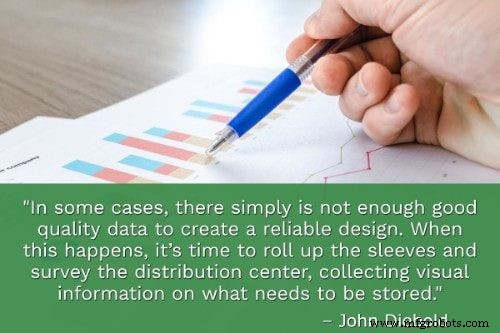
19. 데이터가 충분하지 않습니까? 설문조사를 실시합니다. “어떤 경우에는 신뢰할 수 있는 설계를 생성하기에 양질의 데이터가 충분하지 않습니다. 이런 일이 발생하면 소매를 걷어 올리고 물류 센터를 조사하여 보관해야 할 항목에 대한 시각적 정보를 수집해야 합니다. 일반적으로 이 정보를 수집하는 데 사용할 수 있는 네 가지 방법이 있습니다.
20. 새로운(더 효율적인) 레이아웃은 ROI에 직접적인 영향을 미칠 수 있습니다. “ROI(투자 수익)는 창고 레이아웃 변경 또는 전체 시설 재설계를 고려하는 핵심 요소입니다. 혼잡한 통로는 시간과 효율성을 잃을 수 있습니다. 비효율성으로 인해 주요 선택 위치에서 품절이 발생하여 운영이 저하되고 비용이 발생할 수 있습니다. 추가 오프사이트 창고 공간을 임대함으로써 돈이 낭비될 수도 있습니다. 이러한 요소를 해결하면 건물, 랙 또는 지게차의 손상을 줄이는 것은 물론이고 운영 비용을 절감하고 수익을 개선하는 데 기여할 수 있습니다.” – 전문 창고 컨설턴트를 사용한 창고 최적화 가이드 , 아버 자재 취급; 트위터:@AMH_inc

21. 교통 흐름은 창고 레이아웃 디자인에서 핵심 고려 사항입니다. “이것은 창고 디자인에 대한 분명한 초점처럼 들릴 수 있지만, 건물의 평방 피트를 최대화하기 위해 정기적으로 간과되거나 타협됩니다. 현장 주변의 교통 흐름은 입고를 통해 자재를 현장으로 가져와 최대한 빨리 판매할 수 있도록 하는 데 매우 중요합니다. 영국의 산업 단지에 가면 하역 장소에 접근할 수 있도록 공공 고속도로에 주차된 트럭을 볼 수 있습니다. 이 대기 시간은 체선료와 주문 지연 및 판매 손실 가능성 모두에서 기업에 비용을 초래합니다. 가능한 한 가장 빠른 처리 시간에 상품을 수령, 하역 및 발송할 수 있도록 외부 레이아웃과 교통 흐름이 충분한지 확인해야 합니다.
“효율적인 교통 흐름은 창고 레이아웃과 올바른 구성에 적절한 수의 베이를 통합하는 것에서 시작됩니다. 베이의. 작업 유형에 따라 레벨 액세스 베이와 도크 레벨 베이가 혼합되어 있어야 합니다. 예를 들어, 전자 상거래 운영에서 자재는 측면에서 내리고 수평 접근 베이를 통해 창고에 들어가야 하는 커튼 측면 트레일러에 들어올 수 있습니다. 그러나 배송을 위해 주문은 후방 적재 및 결과적으로 도크 레벨 베이가 필요한 견고한 차량으로 배송될 수 있습니다.” – 창고 디자인 – 성공을 위한 5가지 팁 , Paul Trudigan, Ltd.; 트위터:@paul_trudigan
22. 안전과 인체 공학을 염두에 두고 설계하십시오. “창고가 안전하다는 것은 기업으로서 사고를 줄이고 비용을 증가시키는 것을 의미할 뿐만 아니라; 또한 작업을 보다 원활하고 효율적으로 수행하는 데 도움이 됩니다.
“창고 안전에 대한 이전 블로그 게시물에서 우리는 직원이 구부리고 손을 뻗고 비틀어야 하는 양을 최소화하도록 창고를 설계하여 작업을 더 잘 수행할 수 있는 방법에 대해 논의했습니다. , 부상의 위험 없이. 재고를 두 번 이상 이동할 필요가 없도록 하는 것도 도움이 될 수 있습니다.” – 창고 레이아웃 디자인을 개선하는 4가지 방법 , 케리지; 트위터:@KerridgeCS
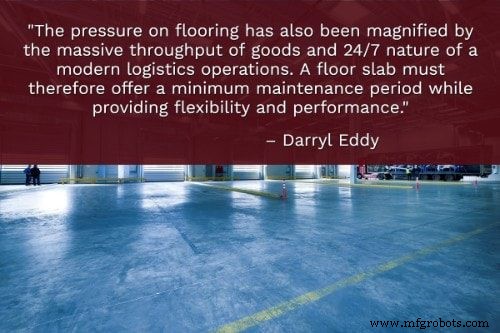
23. 바닥재는 실제로 창고 운영에 상당한 영향을 미칠 수 있는 고려 사항입니다. “창고 바닥재에 대한 강조는 현대 건축 기술로 인해 부인할 수 없이 증가했습니다. 바닥 슬래브의 품질과 내구성은 좋든 나쁘든 창고 공정의 모든 요소에 영향을 줄 수 있습니다. Twintec 산업용 바닥재 이사인 Darryl Eddy는 '많은 창고 및 물류 운영자가 종종 더 크고 높은 건물을 필요로 하는 신기술을 최대한 활용함에 따라 평평한 바닥에 대한 수요가 훨씬 더 높습니다'라고 말합니다.
“압박 바닥재는 대량의 상품 처리량과 현대적인 물류 운영의 24/7 특성으로 인해 확대되었습니다. 따라서 바닥 슬래브는 유연성과 성능을 제공하면서 최소한의 유지 관리 기간을 제공해야 합니다.
“'전통적인 지반 지지 바닥 슬래브 건설은 명목상 상당히 가벼운 메쉬로 보강된 콘크리트를 사용한 다음 톱 절단을 통합하여 사전에 수축 균열을 유도합니다. -계획된 그리드'라고 Eddy는 말합니다. '이러한 조인트가 있는 바닥은 말리기 쉽고 지게차에서는 매우 울퉁불퉁하여 결국 바닥과 기계 모두에서 고장과 지속적인 유지 보수로 이어집니다.'
“창고용 바닥을 설계하고 건설하기 위해서는 바닥 구성 재료의 특성을 이해하는 데 필요합니다. 콘크리트 믹스, 섬유 유형 및 섬유 사용량을 조사하여 창고 운영자는 해당 창고의 요구 사항에 가장 적합한 바닥을 평가할 수 있습니다. 'SFRC(Steel Fiber Reinforced Concrete)'는 복합 재료이며 이음매가 필요 없는 강화 바닥을 생산하는 데 사용할 수 있으므로 지게차와 바닥의 유지 관리를 줄일 수 있습니다.”라고 Eddy는 말합니다." – Darryl Eddy, Middle에서 인용 East Logistics 직원, 창고 설계를 위한 상위 10가지 팁 , 중동 물류; 트위터:@Logistics_ME
24. 비생산적인 통로를 처리합니다. “때때로 낭비되는 공간은 창고 레이아웃에서 시작됩니다. 한때 효율적인 설계였던 것이 이제는 악몽 같은 창고가 될 수 있습니다.
“일부 사람들이 생각하는 것과는 달리 창고 레이아웃은 실제로 매우 유연해야 합니다. 이렇게 하면 제품 확장에서 다양한 크기의 새로운 품목 보관에 이르기까지 시간이 지남에 따라 변화하는 비즈니스를 쉽게 수용할 수 있습니다.
“즉, 디자인을 살펴보거나 전문가를 고용하여 분석하세요. 당신을 위한. 통로가 너무 넓거나 건물 대신 랙 시스템이나 리프트 장비를 기반으로 설계할 수 있습니다.
“레이아웃을 철저히 평가하고 메자닌 또는 모듈식 인플랜트 사무실 설치와 같은 옵션을 검토한 후, 등) 비생산적인 통로가 실제로 문제인지 아니면 실제로 공간이 부족하여 더 큰 시설로 업그레이드해야 하는지 결정할 수 있습니다.” – 비용 절감 없이 비생산적인 통로를 최대화하는 9가지 창고 솔루션 , 전문 스토리지 솔루션
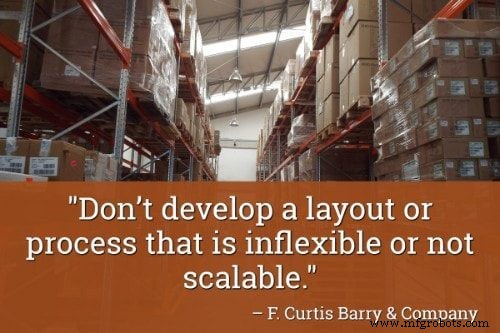
25. 창고 레이아웃 디자인은 유연하고 확장 가능해야 합니다. “사업이나 이행 모델에 대한 알려지지 않은 미래의 변화에 대한 계획은 시설 및 운영에 대한 계획되지 않은 변경을 수행하는 불필요한 비용을 피하기 위해 필요합니다. 유연하지 않거나 확장할 수 없는 레이아웃이나 프로세스를 개발하지 마십시오. 여기에서 효과적인 창고 레이아웃 프로세스를 개발하는 방법에 대해 읽어보십시오.” – 창고 레이아웃 디자인 원칙 , F. Curtis Barry &Company; 트위터:@FCurtisBarryCo
26. 활동 수준과 보관 요구 사항은 이상적인 창고 레이아웃을 결정하는 데 사용할 수 있는 두 가지 중요한 요소입니다. “창고를 설계하는 방법은 시설만큼 다양합니다. 조직의 특정 요구 사항에 따라 동일한 산업 분야에 서비스를 제공하는 창고와 공간이 크게 다를 수 있습니다. 새로운 공간으로 이사하거나 현재 레이아웃을 업데이트할 때 전달할 수 있는 가장 중요한 정보 중 하나는 작업의 전반적인 활동 수준과 저장 요구 사항입니다.
“난방, 냉각 및 습도 제어도 창고 설계에 상당한 영향을 미칠 수 있습니다. 일부는 보관, 충분한 통로 공간, 지정된 수령 및 배송 구역 등과 같은 보다 일반적인 장신구를 필요로 합니다. 다른 일부는 적절한 냉장 공간, 냉장 요구 사항 및 습도 제어 장비로 부패하기 쉬운 식품을 보호해야 합니다." – 창고 설계 서비스를 최대한 활용하기 위한 가이드 , 랙익스프레스; 트위터:@rackexpress
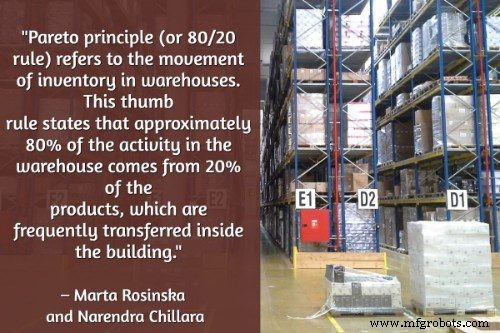
27. 파레토 원칙은 창고의 재고 이동에 적용됩니다. “창고마다 다양한 보관 방법과 다양한 유형의 랙 또는 메자닌을 사용합니다. 다양한 유형의 스토리지 시스템을 조합하는 것은 사용 가능한 공간을 극대화하는 데 매우 중요합니다. 저장장비 보관은 가축의 이동에 따라 선택합니다(Ten Hompel et al., 2007).
“파레토 원칙(또는 80/20 법칙)은 창고의 재고 이동을 말합니다. 이 엄지손가락 규칙에 따르면 창고 활동의 약 80%가 제품의 20%에서 발생하며 건물 내부로 자주 이동됩니다. 다음 15%의 활동은 30%의 재고 유지 단위(SKU)에서 파생되며 이동률은 평균으로 정의됩니다. 마지막으로 활동의 5%는 인벤토리의 50%에서 발생하며 느린 방식으로 저장됩니다. By separating the fast, medium and slow-moving products within the plant and increasing access to products requiring the highest activity, the throughput can be increased significantly.
“Moreover, by facilitating access to these products, additional time can be gained to transfer the products inside the building (Ackerman, 2013).
“Parts with high turnover are usually stored in warehouses with high volumes using pallet racking with standard width passes. Companies that have a reach truck can store products with a high turnover in places where there are narrow aisles. Products with an average circulation are more suitable for storage in narrow aisles. Lastly, it is suggested to store slow-moving products in a very narrow aisle by trucks with rising cabin. However, this is only theory that aim to support the decision how to store goods. Depending on the situation and needs, the scenario might be different (Ten Hompel et al., 2007).” – Marta Rosinska and Narendra Chillara, Layout design planning of a logistics center: A study on space utilization after merger of two warehouses , Department of Technology Management and Economics, Division of Supply and Operations Management, Chalmers University of Technology; Twitter:@chalmersnyheter
28. Unique inbound shipment characteristics can play a role in optimal warehouse design. “Inbound shipment characteristics also play a large role in warehouse design. The ideal inbound shipment? A full palletload from a pre-certified vendor, with a single SKU ready for immediate putaway.
“At the other end of the spectrum, chemical or pharmaceutical materials may require lab testing before they can be accepted for putaway into inventory. This means product must be quarantined in a separate receiving area while it awaits testing.” – Lisa Harrington, Designing the Perfect Warehouse , Inbound Logistics; Twitter:@ILMagazine
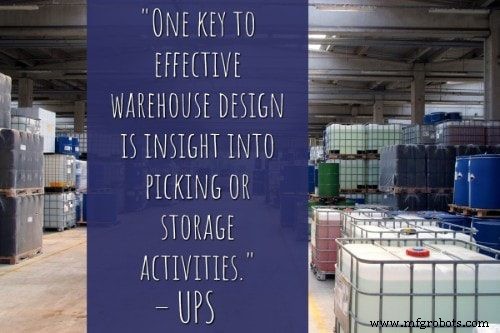
29. Don’t over-complicate picking processes by overemphasizing storage needs. Instead, your goal is to find the perfect balance between the two. “Because warehouses are a buffer for inbound shipments from suppliers and outbound orders to customers, the nature of warehousing often changes from storage to transaction. In addition, overseas sourcing increases the need for warehousing–increasing its importance in the supply chain.
“One key to effective warehouse design is insight into picking or storage activities. A large warehouse space can meet storage needs but complicate picking processes. You need to find a balance for the design of your warehouse.” – Warehouse Design and Layout , UPS; Twitter:@UPS
30. Allow ample space for goods-in. “The goods receiving area of your warehouse is generally a hive of activity, which all too often is crammed into an inadequate space for the purpose.
“While it may seem counterintuitive to give up floor and racking space to expand the goods-in section of your warehouse, releasing a larger floor area here can often lead to greater overall warehouse layout efficiency—and therefore reduced operating costs.” – Rob O’Byrne, 4 Ways to Improve Warehouse Layout Efficiency and Save Costs , Logistics Bureau; Twitter:@LogisticsBureau
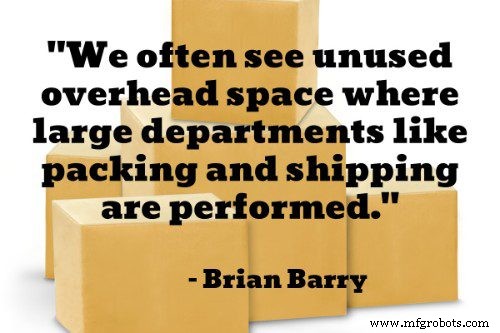
31. Analyze department space to tap into unused overhead space. “Identify functions that do not require high ceilings in areas where lower stacking heights are dictated by the clear height. We often see unused overhead space where large departments like packing and shipping are performed.
“Look up and make sure you’re using all the vertical space available. Investigate storage media to take advantage of your clear span height. How much cubic feet of vertical space is not being used? Be sure to know how your design might impact your sprinkler design and fire code.” – Brian Barry, 15 Ways to Improve Warehouse Space Utilization , Multi-Channel Merchant; 트위터:@mcmmerchant
32. Give forklift operators as wide a path as possible. “Space is also key in maintaining an efficient environment for forklift operation. That doesn’t simply refer to the square footage of the warehouse. It’s possible to have a very large facility with little operable space. The idea here is to provide as a wide of a path as possible for your forklift operators. One easy way to do this is to keep all stored products and packages up against a wall. If your inventory and/or space limitations require the construction of aisles, then make sure you have plenty of space between rows for a forklifts to maneuver without being cramped. The width between aisles will largely depend on the type of forklifts you are using as models vary in terms of turning radius, elevation and reach. Once you’ve identified the forklift models in your warehouse, construct your aisles accordingly. This will not only speed up work flow, it will also go a long way in avoiding accidents..
“Width between aisles isn’t the only important consideration in the layout of your aisles. Logical and proper labeling is also key. As much as possible, try to stack items of a similar kind or category in the same aisle, and make sure each aisle is clearly labeled so employees know which items can be found there. This will avoid hours of confusion and backtracking that can result when employees are not sure where to find specific inventory items. Creating short cuts through aisles can also help to streamline storing and delivery. Putting gaps in the middle of aisles will allow employees to make a direct a path to the items they need without having to walk or drive forklifts around entire aisles to get there.” – Tom Reddon, Best Practices for an Efficient Warehouse Layout , National Forklift Exchange; Twitter:@TomReddon
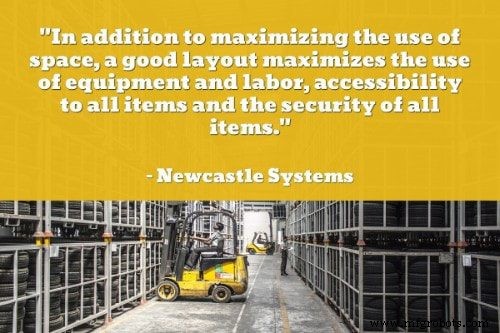
33. An optimized warehouse layout not only maximizes the use of horizontal and vertical space, but also equipment and labor. “The optimal layout factors both the floor space and the vertical space available for use. In addition to maximizing the use of space, a good layout maximizes the use of equipment and labor, accessibility to all items and the security of all items. Using forklifts that reach the roof of the warehouse allows for a configuration that maximizes both the horizontal and vertical space.
“The complementary solution is to ensure that the highest-selling inventory is easily accessible by placing it at the most accessible point.” – Top Five Warehouse Management Problems and How to Fix Them , Newcastle Systems; Twitter:@NewcastleSys
34. Review global layout efficiency. “It’s always been like this and to complicate to change. This is the common comments. Start looking at the global warehouse configuration and think of those 3 basic points:space utilization, productivity and global operation control &management. Look at opportunity to change considering those points:aisle orientation, product flow, incoming and outgoing operation, location of services area (employee access, building services, working area (repack etc)), fix equipment location (stretch wrap, scale, packing tables, etc). Look at measuring productivity per sector or operation and evaluate time consumption and finally review your WMS performance.” – Albert Goodhue, Warehouse Layout Optimization:Some basics steps , GCL Logistics &Supply Chain Consulting
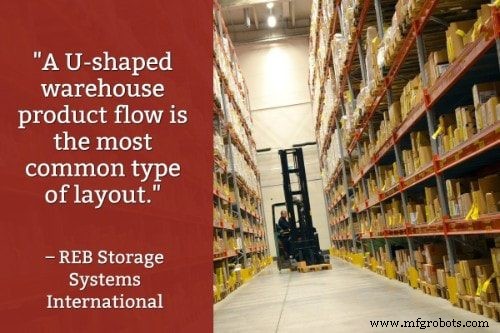
35. A U-shaped product flow is the most common type of warehouse layout, but that doesn’t mean it’s the best layout for your business. “A U-shaped warehouse product flow is the most common type of layout. In this layout the shipping and receiving docks are located next to one another, offering shared utilization of dock resources such as personnel and material handling equipment. This layout also minimizes product handling, offering high cross-docking capability.” – Warehouse Layout &Product Flow Options , REB Storage Systems International; Twitter:@REB_Storage
36. If you need enhanced security, an I-shaped or L-shaped warehouse layout may be better suited to your needs. “I-shaped warehouse product flow and L-shaped warehouse product flow, also known as through flow, are similar in that the shipping and receiving areas are located on different sides of the warehouse. As a result, these require more available warehouse space than U-shaped layouts.
“These layouts can be beneficial for certain operations. For example, warehouses that require heightened security can benefit from the separate ‘in’ and ‘out’ areas. I-shaped and L-shaped layouts can also provide larger sorting and storage areas for both shipping and receiving docks as well as allowing for isolated monitoring of each function.” – Warehouse Layout &Product Flow Options , REB Storage Systems International; Twitter:@REB_Storage
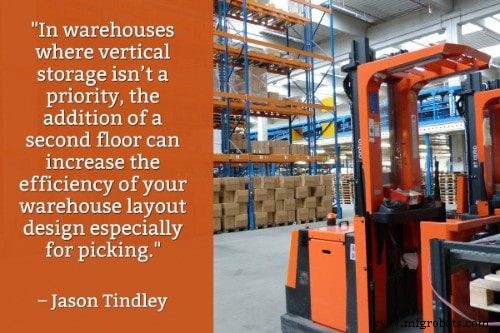
37. Consider adding a floor. “In warehouses where vertical storage isn’t a priority, the addition of a second floor can increase the efficiency of your warehouse layout design especially for picking. Mezzanine floors offer a way to maximize warehouse space without the high costs of complete renovation. These types of floors are ideal for small warehouses looking to expand their space due to increased product demand.” – Jason Tindley, How To Design An Efficient Warehouse Layout In 10 Easy Steps , Logistics Planning Consultants; Twitter:@LPCINT
38. Incorporate cross aisles. “If all of the aisles in your warehouse are long and continuous, it could make getting from one place to another extremely difficult. Increase efficiency by creating a grid of cross aisles.” – 6 Smart Tips on How to Improve Your Warehouse Layout Design , Porta Power, Inc.; Twitter:@PortaPowerInc
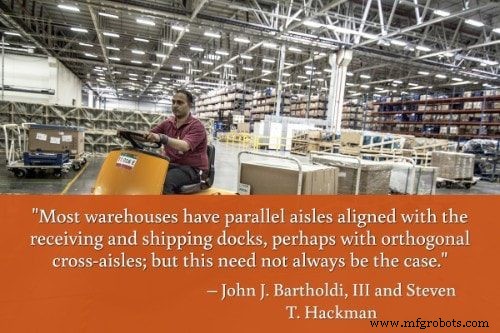
39. A fishbone layout, featuring angled aisles, is touted by some experts. “Most warehouses have parallel aisles aligned with the receiving and shipping docks, perhaps with orthogonal cross-aisles; but this need not always be the case. Kevin Gue of Auburn University and Russ Meller of the University of Arkansas [23] have argued that travel times can be reduced by up to 20% by reorienting some aisles and including some angled cross-aisles, which they call a fishbone layout. The overall warehouse must be slightly larger to compensate for the space lost to the additional aisles; but this is more than made up for by the efficiency of more direct travel to or from a centralized point of receiving and shipping.
“It is possible to take advantage of this more direct travel if most pallet movement is to or from the central dispatch point. But if a forklift finishes putting away a pallet and then must retrieve another, the orientation of the aisles of the fishbone arrangement may not help at all, and indeed may be an impediment. Nevertheless, this possibly inefficiency seems to be more than made up for by the direct travel to and from the central dispatch point.” – John J. Bartholdi, III and Steven T. Hackman, Warehouse &Distribution Science , Release 0.94, The Supply Chain and Logistics Institute, School of Industrial and Systems Engineering, Georgia Institute of Technology (Latest version, Release 0.98, can be downloaded from Warehouse-Science.com)
40. Ensure that processes are positioned closely to other processes and functions they rely on. “The overall layout of the warehouse is an important factor in the optimization of operations. The flow throughout should generally move in either a line or a ‘U’ shape. In this facility there is a single door for both incoming shipments and outgoing orders, so the flow should be in a circular manner. Beginning with reception from the manufacturer, to putaway and replenishment, to order picking and fulfillment, and finally concluding with packaging and delivery to the outgoing shipper, each process should be in close proximity to those it relies upon.” – Tobiah R. Master, Warehouse Redesign of a Facility Layout, Racking System, and Item Classification at Sunrize Tackle, Inc. , California Polytechnic State University; Twitter:@CalPoly
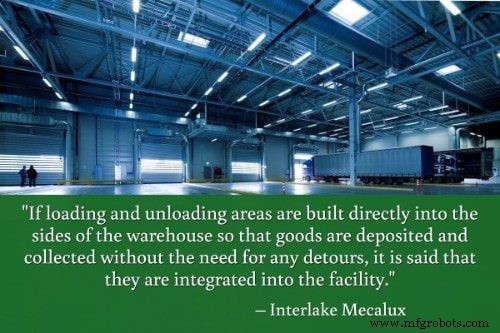
41. If space is available, integrated loading and unloading areas can offer greater load handling speed. “If loading and unloading areas are built directly into the sides of the warehouse so that goods are deposited and collected without the need for any detours, it is said that they are integrated into the facility. The main advantage of this is the greater load handling speed, which means it is preferable to non-integrated options if there is sufficient space for it.
“Trucks are connected to the warehouse via the docks and these docks can be:
42. Design a variety of location sizes to accommodate a greater variety of storage needs and take advantage of all available space. “We see instances where one or two cases stored in a location designed for a full pallet. It is necessary to have a variety of location sizes to accommodate the variety of storage needs on a product by product basis. Another waste of space occurs in picking areas where only the front portion of the pick slot is utilized with empty space left behind. The slotting process should take care of this, but we see it a lot in many warehouses. Make sure the pick slot is designed to fit the cubic velocity of the SKU. It is impossible to attain 100% of capacity on a daily basis but the higher % you can maintain in established locations, the more space you will have available.” – Warehouse Layout and Design Ideas to Begin Improving DC Capacity , F. Curtis Barry &Company; 트위터:@FCurtisBarryCo
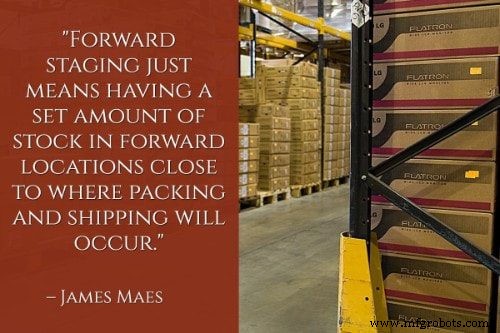
43. Incorporate forward locations to streamline picking efficiency. “Another way to optimize picking is by using forward locations. Forward locations can be a huge time saver, especially with more popular or high-volume items. The idea is to minimize trips to more remote locations in the warehouse at the same time that you minimize the distance a picker has to travel to get an item.
“Forward staging just means having a set amount of stock in forward locations close to where packing and shipping will occur. When an order for one of these items comes in, an employee can choose items from the forward location quickly. As the quantities in the forward location get low, replenishment stock from elsewhere in the warehouse (or from a less expensive off-site location) can then be brought forward.” – James Maes, 8 Tragically Common Mistakes in Warehouse Setup , Infoplus Commerce; Twitter:@infopluscommerc
44. Rethink your rack and shelving solution, and expand vertically. “Rather than expand the footprint of your warehouse, consider better use of vertical space. Adding taller storage units and the right equipment to pick and store material can help you keep more in the same square footage, rather than adding expansion costs. In addition, think about the type and variety of shelving used. Storing small items on pallet racks wastes space, and makes it easy to misplace items. Rather than using the same racks throughout your warehouse, you may need various types of shelving for different materials. Also, try using standardized bins to help keep shelves neat and orderly.” – Danny Hammack, Five simple ways to improve warehouse efficiency , CIPS; Twitter:@supplymgmt
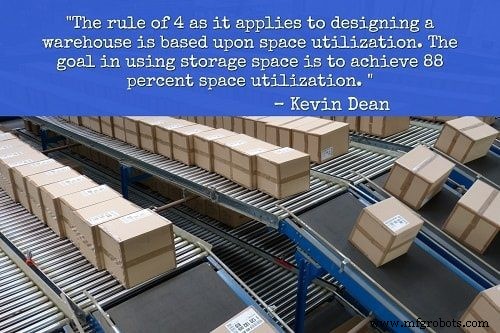
45. Use the Rule of 4 and aim for 88 percent space utilization. “The rule of 4 as it applies to designing a warehouse is based upon space utilization. The goal in using storage space is to achieve 88 percent space utilization. The reason for this is that a higher utilization requires too many aisles to achieve the storage slot space utilization, and therefore is wasteful. A lower utilization causes the warehouse to have honeycombing, which is the phenomenon of a warehouse that has pallet locations filled with half empty pallets – the locations are full and locked up, but the actual storage space contains more air than product.” – Kevin Dean, How to design a space-efficient and productive new warehouse , Raymond Handling; Twitter:@RaymondHandling
46. Other experts suggest that operations run best at about 85% full. A facility under 85% full reduces potential profit. “Inventory is a huge factor in determining an optimized layout for your warehouse. The type of inventory you distribute, the amount, and the length of time the product is in the warehouse are all things that should be taken into consideration during the planning process. Things like the inbound and outbound process as well as the way the items are stored should also be considered. Aside from the type of inventory, you should also consider how much you are going to keep available at your warehouse at any time. Operations run best at about 85% full, anything more than that will be less efficient and anything less would reduce your potential profit. Projected order statistics along with past data can help determine an optimized solution.” – Optimize Your Warehouse Layout , Supply Chain Link; Twitter:@NFIindustries
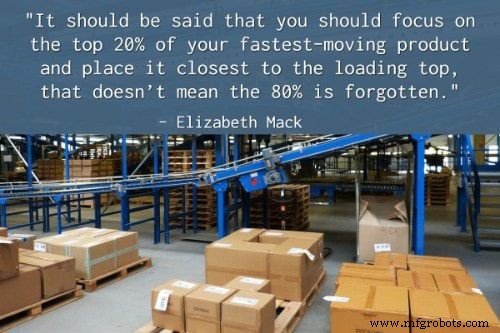
47. Use high-density shelving to organize slow-moving inventory. “It should be said that you should focus on the top 20% of your fastest-moving product and place it closest to the loading top, that doesn’t mean the 80% is forgotten. This is where high-density shelving systems come into play.
“In particular, high-density shelving systems are great for storing slow-moving product. Often times, businesses are so focused on their fast-moving product that slower-moving product is put on the wayside.
“What this type of shelving system does is double your storage capacity and make it easy and efficient for employees to retrieve inventory. Its accessibility and space-saving features are the reasons why we added it to the list.” – Elizabeth Mack, Warehouse Solutions You May Need to Make Your Facility More Efficient , Specialized Storage Solutions
48. Incorporate the four functional warehouse zones in your layout. “The top 4 functional warehouse zones identified using forecasting and projections are storage, yard/dock, picking and VAS/kitting zones. To identify the proper size of the storage area evaluate key factors such as project inventory levels, temperature requirements, product dimensions, fulfillment rules, flow through rates and more. All of these factors will play a part in determining proper storage layout. Data must also be collected to determine yard and dock door requirements. Too little staging space and dock doors can create a significant bottleneck, slowing down warehouse productivity. When determining picking and shipping size and location identifying your picking strategy will help to make these decisions. Consider the space requirements needed for all types and which will work best for your available resources.” – Cold Storage Warehouse Best Practices:Warehouse Layout Optimization , Datex; Twitter:@Datexcorp
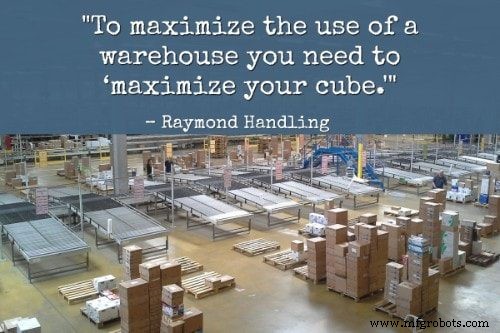
49. Maximize your cube. “To maximize the use of a warehouse you need to ‘maximize your cube.’ You need to take advantage of all of the vertical space that you have available. With a conventional fire protection system you can stack products up to 18” below the fire sprinkler heads. In an ESFR (Early Suppression, Fast Response) system this distance is 36”. You may need to reconfigure your existing storage system to take advantage of this space but it could be worth the effort.” –
How to optimize your existing warehouse space , Raymond Handling; Twitter:@RaymondHandling
50. Keep special processing areas under control. “Create space-saving layouts for special processing areas such VAS and returns. According to Elenbark [Bill Elenbark, senior engineer for the supply chain consulting firm TranSystems], special processing areas have a tendency to creep in size and spread out over larger areas than are required. It may be high time to take a closer look and consider making space-saving changes. If a lot of pallets are sitting on the floor, consider adding a short section of pallet rack to take advantage of cube. Carousels can be used as buffers to accumulate processed returns before returning them to inventory.” – Maida Napolitano, Space Optimization:Mission Impossible? , 물류 관리; 트위터:@LogisticsMgmt
Products and Tracking Solutions from Camcode:
산업기술
SLA(Stereolithography)는 광원을 사용하여 감광성 액체 수지를 고체 형태로 경화시키는 적층 제조 공정입니다. SLA는 매끄러운 표면 마감과 뛰어난 설계 기능 해상도로 매우 정확한 등방성 부품을 생산할 수 있어 복잡한 프로토타입, 마스터 패턴 및 스케일 모델을 생산하는 데 이상적입니다. 그러나 대부분의 제조 공정과 마찬가지로 부품의 품질과 실행 가능성은 관련된 변수를 최대한 많이 제어하는 데 달려 있습니다. 예를 들어 달성할 수 있는 세부 사항의 수준은 광원의 크기 및 수지의 재료 특성과 같은 요인에 따라 다릅
이 3부작 시리즈의 2부에서 저자는 호스 튜빙 및 라우팅이 유지 관리를 단순화하고 호스 고장을 줄이는 방법에 대해 설명합니다. 여기에서 1부와 3부를 읽어보세요. 기계 프로토타이핑 중에 구성 요소를 운반하는 유체를 올바르게 배치하고 올바르게 설치하려면 다음 10가지 일반 규칙을 따르십시오. 이러한 지침은 기계 프로토타이핑 중에 가장 유용합니다. 모든 버그가 제거된 후 정상적인 제작 절차를 따라야 합니다. 큰 줄부터 시작 — 가장 큰 ID 라인은 특히 좁은 공간에서 구부리고 조작하기 가장 어렵기 때문에 먼저 설치하십시오. 그